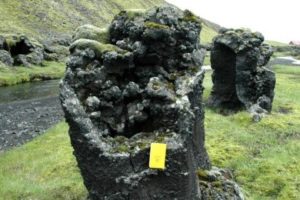geological society of america
Earth’s first great predator wasn’t
Boulder, CO, USA – The meters-long, carnivorous “shrimp” from hell that once ruled the seas of Earth a half billion years ago may have been a real softy, it turns out. A new 3-D modeling of the mouth parts of the Anomalocaris, along with evidence th…
How lead gets into urban vegetable gardens
Boulder, CO, USA – One common mitigation approach is to build a raised bed and fill it with freshly composted, low-lead soil from elsewhere, right? Maybe not, according to researchers studying the mysterious case of the lead contamination found with…
Scarcity of new energy minerals will trigger trade wars
Boulder, CO, USA – It’s not hard to argue in favor of alternatives to fossil fuels these days, but one popular argument — domestic energy security — may be standing on very shaky legs. A lot of rare metals are needed to make photovoltaic panels,…
Raising giant insects to unravel ancient oxygen
Boulder, CO, USA – The giant dragonflies of ancient Earth with wingspans of up to 70 centimeters (28 inches) are generally attributed to higher oxygen atmospheric levels in the atmosphere in the past. New experiments in raising modern insects in var…
Found: First complete remains of early sauropod dinosaur
Boulder, CO, USA – Scientists have discovered in China the first complete skeleton of a pivotal ancestor of Earth’s largest land animals — the sauropod dinosaurs. The new species, tentatively dubbed Yizhousaurus sunae, lived on the flood p…
Algeo tracks evidence of ‘The Great Dying’
More than 251 million years ago, at the end of the Permian period, Earth almost became a lifeless planet. Around 90 percent of all living species disappeared then, in what scientists have called “The Great Dying.”
Thomas J. Algeo, has spent much …
Tornado warnings are too often ignored
EAST LANSING, Mich. — With big storms ripping across the Midwest, Bob Drost is hoping people are paying attention to the severe weather and tornado warnings.
Unfortunately, Drost, a doctoral student at Michigan State University, knows that many…
‘Fracking’ mobilizes uranium in marcellus shale
BUFFALO, N.Y. — Scientific and political disputes over drilling Marcellus shale for natural gas have focused primarily on the environmental effects of pumping millions of gallons of water and chemicals deep underground to blast through rocks to…
Professor says volcanic eruptions in Costa Rica 'inevitable'
It might be 500,000 years or five years, but the Central Valley of Costa Rica will definitely experience major volcanic activity again, according to Phillip B. Gans, professor of geology at the University of California, Santa Barbara. He presented a study of volcanic rocks of Costa Rica in his recent talk at the annual meeting of the Geological Society of America.
Mars May Be Much Older — or Younger — than Thought
Research by a University at Buffalo planetary geologist suggests that generally accepted estimates about the geologic age of surfaces on Mars — which influence theories about its history and whether or not it once sustained life — could be way off. Funded by the National Aeronautics and Space Administration, the research eventually could overturn principles about the relative ages of different areas on the Red Planet that have not been questioned for nearly 20 years.
Red Freckles on Europa Suggest ‘Lava Lamp’ Action
 Reddish spots on the icy surface of Jupiter’s moon Europa may indicate pockets of warmer ice rising from below. This upwelling could provide an elevator ride to the surface for material in an ocean beneath the ice, say scientists studying data from NASA’s Galileo spacecraft.
Reddish spots on the icy surface of Jupiter’s moon Europa may indicate pockets of warmer ice rising from below. This upwelling could provide an elevator ride to the surface for material in an ocean beneath the ice, say scientists studying data from NASA’s Galileo spacecraft.

